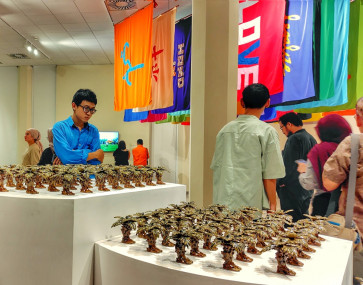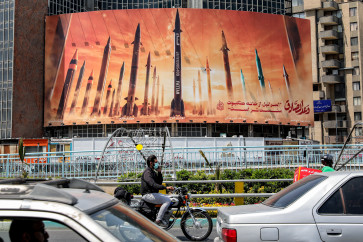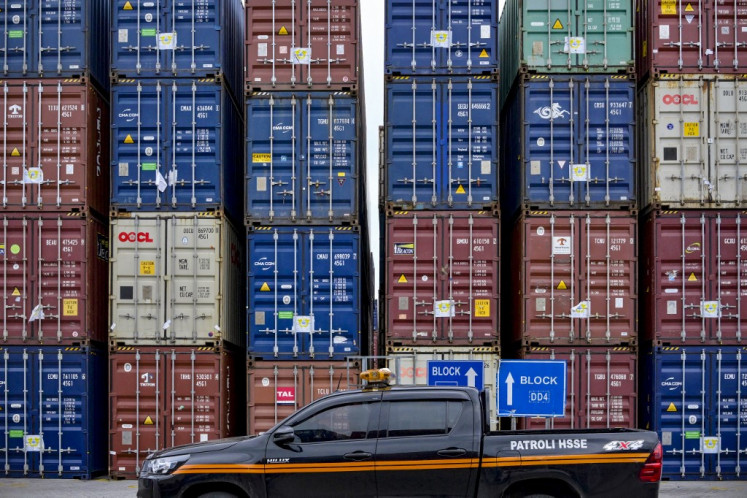Popular Reads
Top Results
Can't find what you're looking for?
View all search resultsPopular Reads
Top Results
Can't find what you're looking for?
View all search resultsBiogas: Renewable energy worth spreading in Gorontalo
Free and clear: Negative attitudes faded after people realized that there were no side effects or bad taste from eating food cooked with biogas
Change text size
Gift Premium Articles
to Anyone
F
span class="caption" style="width: 510px;">Free and clear: Negative attitudes faded after people realized that there were no side effects or bad taste from eating food cooked with biogas.The unpleasant smell of methane arising from the animal waste doesn't repel him at all.
This is the daily routine of Yosep Utina, 48. The cow breeder in Huluduotamo village, in Bone Bolango, Gorontalo, lets none of the waste go to waste.
Inside the 1.7-meter-high tank, the dung will decay to produce about 13 cubic meters of biogas, which Yosep drains off with polyvinyl pipes typically used for drinking water.
The pipes span 135 meters to his house, where Yosep's wife, Elistin Alim, cooks with the biogas produced. It's a system that makes economic and environmental sense.
'Ten families in my neighborhood are now sharing this biogas to prepare their meals,' said Yosep, who for reasons of goodwill freely shares his biogas with his neighbors.
Yosep's biogas even powered gas lamps before the village was electrified.
For almost seven years, Yosep and family have created gas by processing the manure of his 20 cows.
'As long as my cows keep discharging enough excrement, my family will continue to enjoy free biogas for daily use,' Yosep said.
In 2006, the local government sent him to Bandung, West Java, for a course on cow breeding that taught him how to convert manure into biogas, an environmentally friendly source of renewable energy.
He returned and was eager to put his learning to use.
Initially, people were skeptical or even disgusted about cooking with gas derived from manure, he says. However, the negative attitudes faded after people realized that there were no side effects or bad tastes from eating food cooked with biogas.
An adult cow can produce up to 12 kilograms of excreta a day. The daily waste from three cows can be converted into the biogas equivalent to of 2 liters of kerosene. Thrifty: The daily waste from three cows can be converted into biogas equivalent to 2 liters of kerosene.
'One liter of non-subsidized kerosene or three kilograms of LPG [liquefied petroleum gas] in Gorontalo costs Rp 16,000 [US$1.32], meaning Rp 32,000 for 2 liters, which we can save every day for other household needs,' he adds.
Yosep, who leads a farmers and fishermen collective in Suwawa, says that the system is safe. The stoves he uses are off-the shelf models that require slight modification before they can start cooking.
And the concrete tank where the manure is processed has an estimated life expectancy of 30 years.
He uses a manometer to keep track of the pressure of the biogas. It shows the amount of gas fed to the stove through a water-filled transparent hose.
If the pressure soars as gas builds in the supply tank, the hose will release the water along with the excess gas. However, Yosep said that this has never happened in his years of experience.
Yosep, who never went to university, now frequently speaks and presents papers on biogas. He has been working for several months as a field instructor, teaching farmers how to raise cows and how to turn the animals' manure into biogas.
His farm/refinery also serves as a laboratory for agriculture and animal husbandry students from nearby vocational schools.
'The first test the students have to undergo is to grasp cow dung with bare hands,' he said.
Yosep says he built 43 biogas units throughout the regency in 2013 and will build 75 units in 2014, funded by a special allocation from the regency administration. The sites are located at farms where cows are raised.
The main constraint is cost: A 4-cubic-meter biogas tank that can provide five households has a price tag between Rp 8 and 12 million.
'If residents wish to buy biogas equipment at their own expense, they should do it collectively by mutual assistance,' Yosep said.
While building processing units has been supported by the government, Yosep says, officials should support developing biogas nationally and help cut through the red tape.
Individual building costs, he suggested, could be subsidized through a program modeled after social aid and other self-supporting community initiatives.
There seems to be no shortage of public interest.
For example, Asna Lasamoli is a local housewife who has reaped the financial benefits of biogas.
Previously, she used firewood or 3-kilogram canisters of LPG for cooking.
She smiled. 'Now I needn't fuss about buying LPG.'
Another convert is Darwan Botutihe, a cow breeder in Dutohe village in Bone Bolango regency. He says that there is another advantage to the biogas tank that he and some friends have recently built.
'We can also utilize the residue from the waste after processing to make environmentally oriented organic fertilizer, which also has resale value.' Darwan said. 'Nothing is discarded.'
' Photos by Syamsul Huda M. Suhari











